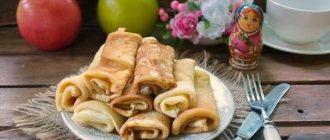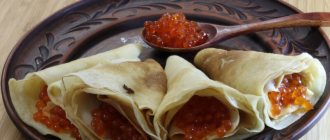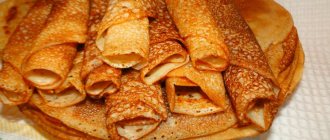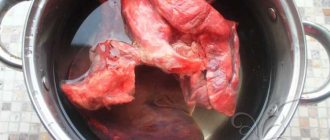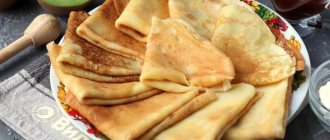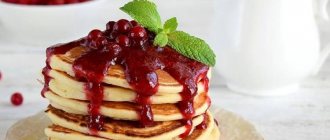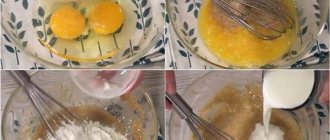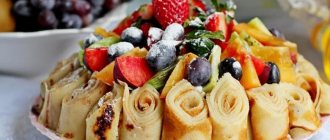If you've never made pancakes before, you'll be surprised how easy they are to make. Pancakes are a traditional breakfast dish that is easy to make. Once you have a basic recipe, you can start experimenting. If you want to try making your own pancakes, here's everything you need to know:
Pancakes are made from a simple dough made from flour, milk and eggs in a hot frying pan. In addition to these three ingredients, baking powder is needed to make the pancakes rise and turn out airy and light. Be sure to use baking powder and not baking soda - they are not the same thing.
You also need to add a small amount of salt and sugar to the batter, and a little pure vanilla extract.
How to fry pancakes with milk recipe
Our grandmothers knew very well how to cook delicious pancakes with milk. We have posted this wonderful recipe below especially for you.
Mix in a deep bowl:
- 2 eggs,
- a glass of flour,
- a teaspoon of salt,
- a tablespoon of sugar,
- a glass of warm milk.
Stir and add a little vegetable oil. Next, you need to let the pancake mixture sit.
Many people are interested in how long she should rest? About 10 minutes.
Next, stir the mixture again and start baking our pancakes. To prevent milk pancakes from sticking to the surface of the frying pan, it is worth greasing it with a piece of butter, instead of the usual vegetable analogue.
What to consider when kneading the dough?
Before frying the pancake, you need to knead the dough correctly. To do this, it is best to use a deep enamel pan or bowl with high sides, in which you can calmly stir the dough. If you add yeast, then the container must be at least three times larger in volume than the volume of the finished dough, taking into account the fermentation process.
There are a few simple rules when kneading dough:
- The liquid - whey, water, milk or kefir - must be heated. If you are preparing yeast dough, heat the liquid to a maximum temperature of 42-45 degrees, otherwise the yeast will spoil at a higher temperature. Even if you don't use baking powder, you still need to warm the milk or water a little so that the sugar and salt dissolve more easily.
- Too many eggs make the pancake very dense, but if they are missing, the dough may tear when trying to turn the pancake to the other side during frying. It is optimal to take about 2 chicken eggs per half liter of liquid.
- It is better to dilute pancakes with milk slightly with water, then they will turn out fluffier and easier to rise.
- As a leavening agent, you can use dry or fresh pressed yeast, soda, a special baking powder, or add nothing at all. In the latter case, you can make the thinnest plastic pancakes possible.
- Fat must also always be added to the dough, otherwise the pancakes will stick to the pan. This can be any odorless vegetable oil, as well as melted margarine, cooking fats, and butter. For half a liter of liquid, adding 2-3 tablespoons of fat is enough. You can add 1 tablespoon of butter to pancakes made with milk.
We recommend: How many milligrams in one gram: accurate calculations
It is not necessary to knead the pancake dough for a long time; it is enough to combine all the components well. After kneading, cover the bowl with the dough with a cloth or gauze so that it has access to air. Yeast dough rests for at least half an hour; regular dough or baking soda should sit for about 10-15 minutes before frying the pancakes.
How to fry pancakes with meat in a frying pan
If you decide to opt for stuffed pancakes with meat, you should know a few basic points.
Regardless of whether you want to prepare a classic version of this dish, or give preference to sultanas, first of all, you should fry the pancakes themselves and the filling in different frying pans.
Next, after both ingredients have cooled, start stuffing. After this, you should fry the spring roll again.
How long to fry this dish, you ask. No more than a couple of minutes on each side.
This is necessary so that the pancake secures its shape and the filling does not fall out.
How to choose a frying pan?
A good frying pan is the main key to the success of baking pancakes from absolutely any dough. In ancient times, pancakes were always baked in a real Russian oven. Today you can hardly find one like this, although it is the Russian oven that creates optimal conditions for the pancake dough to flow well, distributes uniform heat over the products, and does not leave uncooked parts or lumps.
Before frying the pancake, the pan must be washed and wiped with a napkin. Modern housewives use the following types of pans to make pancakes:
- Teflon frying pans are equipped with a special non-stick coating, for example, ceramic, due to which the pancakes do not stick, even the first one, which is usually “lumpy”. It is allowed to turn pancakes in such a frying pan only with silicone or wooden spatulas, so as not to scratch the coating. If you are the lucky owner of a Teflon frying pan with a heating indicator in the form of a red circle in the center of the bottom, then you are even luckier. Such a frying pan will accurately indicate when it is evenly heated.
- Perhaps every housewife has cast iron frying pans in her family. Among their advantages are the uniform degree of heating of the entire surface and long-term heat retention. The downside is that frying pancakes in a cast iron frying pan for quite a long time, distributing the dough over the frying pan, your hand may simply get tired, since cast iron products weigh quite a lot.
The choice of frying pan determines at what heat to fry the pancakes. The thinner the bottom, the faster the dough will bake. How long to fry a pancake also depends on the diameter of the burner.
We recommend: How many grams of sugar are contained in one tablespoon
Some housewives even use a microwave to fry pancakes, but the pancakes in it are not so juicy and often do not have a golden brown crust. In addition, pancakes can be fried in a special electric device - a pancake maker. This device is a housing with a heating element and a small tray with low sides into which the dough is poured. The pancake maker allows you to avoid using oil at all when frying pancakes; it cooks them very quickly and cooks evenly on both sides.
It is optimal to choose a frying pan with small sides located at an obtuse angle to the bottom. This will give you the opportunity to carefully pry the pancake, turn it over and not tear it.
How to make the cooking process easier?
The process of frying pancakes can be greatly simplified if you follow some simple tips:
- The pancake batter must be poured into a very well-heated frying pan, pre-greased, strictly in the center. After this, tilt the pan and use circular movements to spread the dough into an even layer. The holes can be closed with small drops of dough.
- If a lot of bubbles form during the frying process, it means there is not enough flour in the dough. Add a little at a time so that the pancakes do not come out too thick and undercooked. One large bubble in the center can simply be carefully pierced with a fork, being careful not to scratch the surface of the pan.
- If the pancake breaks when you try to turn it over to the other side, it means you made the dough too liquid. Add a little flour and one egg. It is the egg that makes the pancake dough plastic, and the finished products - dense and tear-resistant.
- Pancakes may stick to the surface of the pan due to poor coating or uneven heating. Make sure that the fire is located clearly in the center of the pan. If you cook in a cast iron frying pan, before frying you can calcine it with salt, then wipe it dry, then grease it with vegetable oil and start frying.
- For turning, it is best to use a wide silicone spatula. You need to turn the pancake over when its surface is not shiny and the edges are already slightly browned.
- If the pancake breaks when you turn it over, it means there is too much flour in the batter and not enough milk or eggs.
It is better not to store the finished pancakes, but to serve them immediately. But you can freeze them, including the fillings, and then reheat them in the microwave.
A Beginner's Guide to Making Perfect Pancakes
The frying pan is one of the basics that is worth paying attention to. Electric frying pans are more convenient because you can set the temperature you want and it will stay that way. So if you're new to making pancakes, we recommend using an electric griddle and you'll have one less variable to worry about.
You can use a cast iron, stainless steel or aluminum frying pan, or if you're a millionaire, a copper one) joke. Almost any regular frying pan will do. Use the widest pan possible if you plan to cook pancakes, so you have room for several at once.
Ingredients
With the following ingredients you will be able to make about 10 small pancakes measuring about 25cm (larger or smaller depending on the size of the pan and your preference) - you can adjust the quantities according to the amount you want to serve:
- 2 cups all-purpose flour (510 g)
- 1.5 cups whole milk (350 ml)
- 2-3 large eggs
- 2 tablespoons butter or vegetable oil
- 2 teaspoons baking powder
- 5 tablespoons sugar
- 1/2 teaspoon vanilla extract (optional)
- a pinch of salt
See also: What heat should you use to fry pancakes
? Make sure the baking powder is fresh. If it's older than six months, your pancakes won't be as fluffy.
What oil to fry in?
What oil to fry pancakes in is very important. Oil must be added to the pancake dough, otherwise the finished pancake will turn out very dry and lose its fluffiness. The bulk of pancake recipes contain vegetable oil, not only sunflower, but also corn, olive and other refined oils. Alternatively, you can use melted, cooled butter, shortening or quality margarine.
Before frying pancakes, warm the oil to room temperature. The standard portion of oil per half liter of liquid is 2 tablespoons. Refined must be used so that the dough does not have a characteristic odor.
In addition to butter, you can use a piece of fresh lard; usually either salted or fresh without spices is used. Also lubricate the pan in a small amount, otherwise it may not have a very pleasant aroma when heated.
To save a portion of oil, you can use a long-proven method - peel one medium potato, cut it in half, and prick it on a fork with the cut side down. Then dip this cut in vegetable oil and grease the surface of the frying pan with it. Grease the frying pan with lard in the same way - prick it on a fork and turn it over periodically.
We recommend: How to prepare invert syrup at home?
It is not advisable to use too much oil when frying. Once you have coated the surface with oil and it is well heated, spread it around the pan in a circular motion and pour out the excess.
How to cook pancakes
Heat the pan to 190°C. Typically, an electric frying pan has an indicator light that lights up when it reaches the desired temperature. Heat a regular frying pan over medium heat until a drop of water “starts to dance.” If nothing happens to the drop, the surface is not heated enough, and if it instantly hisses and evaporates, it means it is too hot.
Pour a small amount of vegetable oil onto the surface of the pan. Wipe off any oil around the surface with a paper towel until the surface is lightly coated. At the edge of the pan, pour 1/4 cup of batter (pancake size) or more depending on desired size. If two pancakes merge into each other, it's okay. You can use a spatula to separate them just before turning them over.
See also: How to flip a pancake in a frying pan: secrets from chefs

